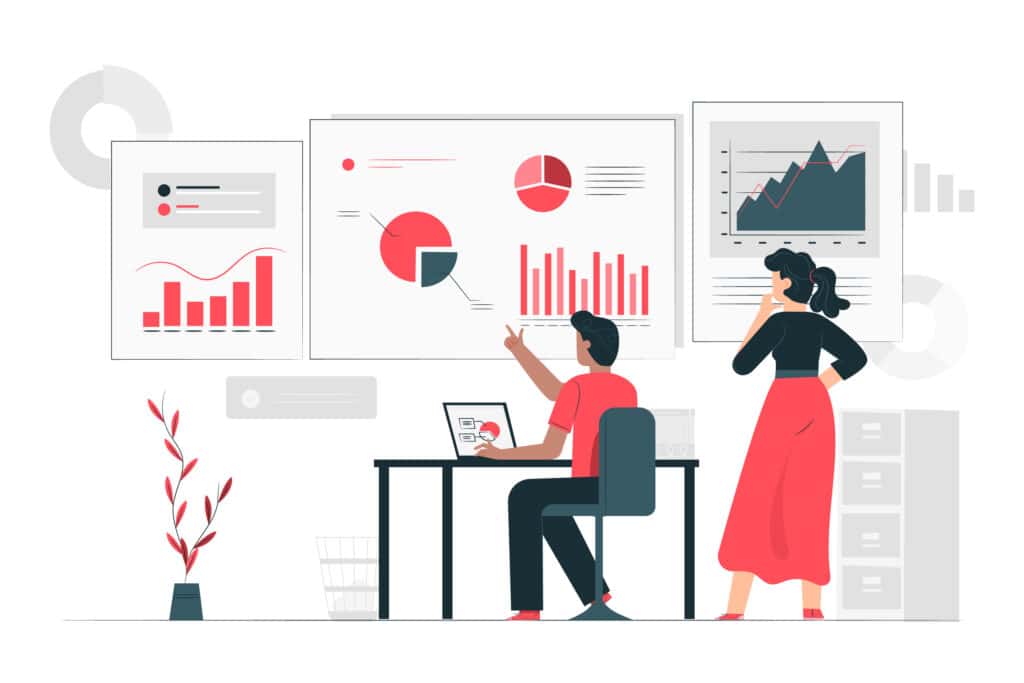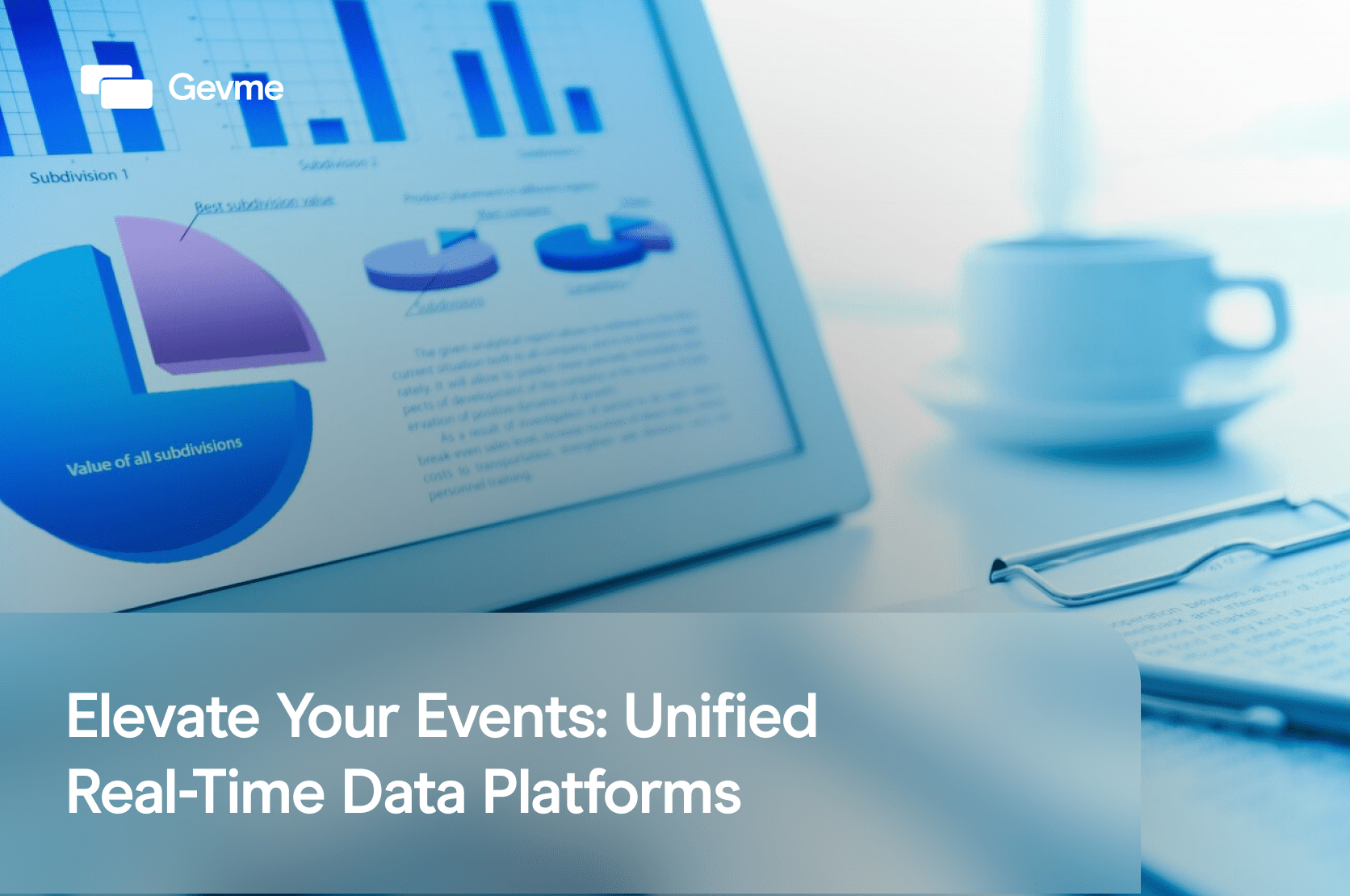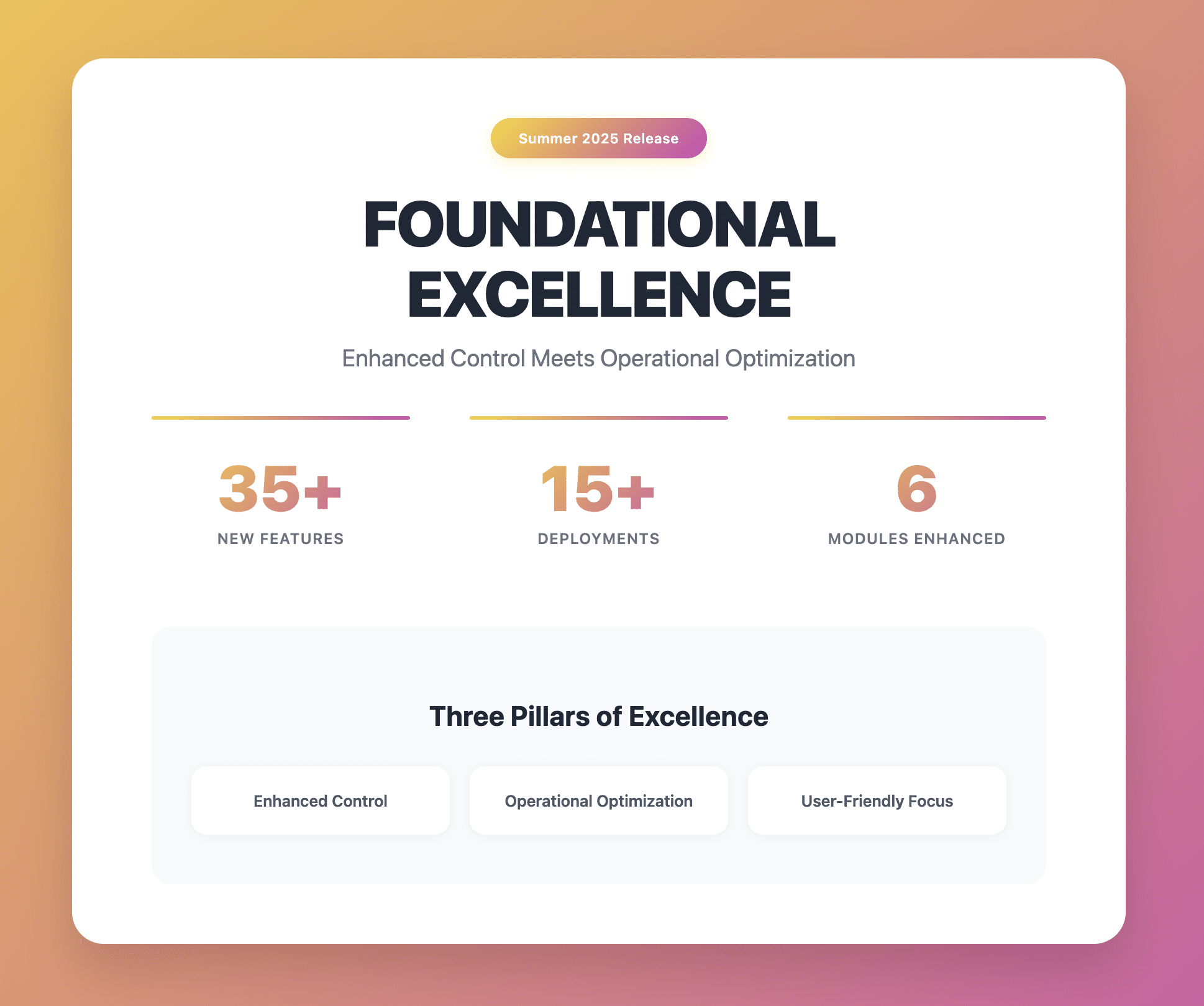In an era marked by unprecedented digital transformation, the events industry has witnessed a profound shift in the way gatherings are organized, experienced, and leveraged for various purposes. The advent of digital events, fuelled by technological advancements, has redefined the boundaries of what’s possible. From webinars and virtual conferences to hybrid events that blend the physical and digital realms, the digital event landscape has evolved at an astonishing pace.
However, as the scope and scale of digital events have expanded, so too have the complexities associated with managing them. Enter the era of data-driven digital events—a paradigm where insights, analytics, and real-time information are the cornerstones of success.

I. The Digital Event Evolution
The journey from traditional physical events to digital experiences has been a fascinating one. It’s a transformation that has been both accelerated and necessitated by global circumstances. The COVID-19 pandemic served as a catalyst, propelling digital events to the forefront of our collective consciousness.
- Challenges and Opportunities of Digital Events
The rise of digital events brought forth a unique set of challenges. Event organizers had to grapple with ensuring attendee engagement in a virtual environment, replicating the networking opportunities of physical events, and adapting to new technology. However, these challenges also opened doors to novel opportunities, such as global reach, reduced logistical constraints, and enhanced data collection.
- The Data-Driven Imperative
Amid these challenges and opportunities, one truth became evident: data would be the linchpin of success in the digital event era. The ability to gather, analyze, and act upon data in real-time has become the cornerstone of event planning and execution.
II. Understanding Unified Real-Time Data Platforms
1. Defining Unified Real-Time Data Platforms
At the heart of this data-driven revolution are unified real-time data platforms. These platforms are more than just data repositories; they are dynamic ecosystems that gather, process, and deliver actionable insights in real time.
Unified real-time data platforms bring together various data sources, including attendee profiles, session interactions, feedback surveys, and even external data streams like social media. These platforms consolidate this data into a single, coherent source of truth that event organizers can access and analyze instantly.
2. Key Components and Functionalities
Unified real-time data platforms consist of several key components and functionalities:
- Data Aggregation: These platforms collect data from diverse sources, including registration forms, attendee interactions, and session participation.
- Data Processing: Advanced algorithms process this data, identifying patterns, trends, and anomalies.
- Real-Time Analytics: The hallmark of these platforms is their ability to provide real-time insights. Event organizers can monitor attendee behavior, session popularity, and engagement metrics as they happen.
- Customized Dashboards: Unified real-time data platforms often offer customizable dashboards, allowing event organizers to tailor the data visualization to their specific needs.
- Integration Capabilities: Many platforms seamlessly integrate with other event management tools, such as registration systems and marketing automation software.
3. How These Platforms Differ from Traditional Data Management Systems
It’s crucial to distinguish unified data platforms from traditional data management systems. While traditional systems often focus on data storage and batch processing, real-time platforms prioritize instant access to data insights.
Traditional systems might offer historical data analysis, while real-time platforms provide up-to-the-minute insights that empower event organizers to make informed decisions on the fly.
4. Real-Time Data Processing
One of the defining features of unified real-time data platforms is their ability to process data in real-time. This means that as attendees interact with various elements of a digital event, such as sessions, exhibitor booths, or networking lounges, their actions are instantly recorded and analyzed.
For example, if an attendee joins a virtual session, their participation is immediately logged. This real-time data can be used to gauge session popularity, identify engagement trends, and even suggest personalised content recommendations to other attendees.
Real-time data processing extends beyond attendee interactions. It encompasses everything from monitoring event performance metrics, such as registration numbers and ticket sales, to tracking social media mentions and sentiment analysis.

5. Personalization at Scale
One of the most powerful capabilities of unified real-time data platforms is their ability to enable personalization at scale. Event organizers can harness attendee data to create tailored experiences that resonate with individual preferences and goals. Attendees receive session recommendations based on their interests and behavior, ensuring they make the most of their event experience. This personal touch extends to networking opportunities, where attendees are matched with potential connections who share common interests or objectives.
Personalization not only enhances attendee satisfaction but also drives engagement, ultimately leading to more successful digital events. By understanding the inner workings of unified data management solutions, event organizers can unlock a world of possibilities in the realm of digital events. These platforms empower organizers to make data-driven decisions, enhance attendee engagement, and create personalized experiences on a scale previously unimaginable.
III. Advantages of Unified Real-Time Data Platforms in Digital Events
Unified real-time data platforms are more than just tools; they are transformative enablers for event organizers. Let’s explore in greater detail how these platforms enhance digital events:
1. Enhancing Attendee Engagement Through Personalized Experiences
In the digital event landscape, attendee engagement is a paramount concern. Without the physical presence of participants, event organizers must find innovative ways to keep attendees actively involved. Unified real-time data platforms rise to this challenge by offering unparalleled personalization.
Attendees receive customized recommendations for sessions, exhibitors, and networking opportunities based on their interests, past interactions, and behaviour within the event platform. This not only makes attendees feel valued but also ensures they have a meaningful and relevant experience.
Furthermore, unified real-time data platforms allow event organizers to make instant adjustments. If a particular session is not resonating with attendees, organizers can swiftly redirect participants to more appealing content, ensuring a dynamic and engaging event environment.
2. Streamlining Event Logistics and Operations
Beyond attendee engagement, unified real-time data platforms streamline event logistics and operations. For event organizers, managing the intricacies of a digital event can be daunting, with countless moving parts and variables to consider.
Unified real-time data platforms offer a bird’s-eye view of event operations. Organizers can monitor attendee registrations, ticket sales, and session attendance in real-time. This data-driven approach enables proactive decision-making, such as adjusting session schedules or increasing support resources in response to attendee needs.
Additionally, unified real-time data platforms extend to exhibitor and sponsor management. Organizers can gauge exhibitor booth traffic, track lead generation, and ensure sponsors receive the visibility they expect, all while the event is ongoing.
3. Enabling Data-Driven Decision-Making for Event Organizers
Unified real-time data platforms empower event organizers with the insights they need to make data-driven decisions. As attendees interact with the event platform, data streams in real time, providing a wealth of information.
Organizers can identify trends, spot opportunities for improvement, and adjust their strategies on the fly. For instance, if a certain topic gains unexpected popularity among attendees, organizers can quickly allocate additional resources or schedule follow-up sessions to meet demand.
Moreover, real-time data allows for A/B testing and experimentation. Event organizers can tweak elements of the event, such as the timing of sessions or the format of networking sessions, and immediately assess the impact on attendee engagement.
4. Real-Time Analytics and Insights for Event Success
Real-time analytics are the heartbeat of unified data platforms. These platforms provide event organizers with a dashboard that displays key metrics and KPIs as they evolve during the event.
Organizers can track metrics like attendee engagement levels, session attendance rates, and even sentiment analysis of attendee interactions. Real-time analytics provide instant feedback on the effectiveness of event content and activities, allowing organizers to optimize the event on the fly.
With these insights at their fingertips, event organizers can identify areas of improvement and take immediate action to enhance the attendee experience.

IV. Practical Tips for Implementing Unified Real-Time Data Platforms
Now that we understand the significant advantages unified real-time data platforms bring to digital events, it’s essential to delve into practical strategies for their effective implementation:
1. Selecting the Right Unified Real-Time Data Platform
The first step is to choose the most suitable unified real-time data platform for your event’s specific needs. Evaluate platforms based on factors like ease of integration with your existing event technology stack, scalability, customization options, and real-time capabilities. Platforms like Gevme offer robust solutions designed to seamlessly integrate with various event components.
2. Integrating with Existing Event Systems
To maximize the value of your unified real-time data platform, ensure it integrates seamlessly with other event management systems you use, such as registration and ticketing tools, marketing automation, and virtual event platforms. This integration ensures a unified data ecosystem, eliminating silos and streamlining data flow.
3. Customizing Data Dashboards
Leverage the customization features of your chosen platform to tailor data dashboards to your specific event’s needs. Highlight the KPIs and metrics most relevant to your objectives and key performance indicators, ensuring quick access to essential insights during the event.
4. Training Event Staff and Teams
Adequate training is crucial to harness the full potential of your unified real-time data platform. Equip your event staff and teams with the skills and knowledge required to use the platform effectively. This includes understanding how to interpret real-time data, make informed decisions, and implement necessary adjustments during the event.
5. Data Security and Compliance
With the wealth of data collected and processed in real time, data security and compliance are paramount. Ensure your chosen platform adheres to robust security protocols and compliance standards, such as GDPR. Protecting attendee data and maintaining trust are non-negotiable priorities.
6. Monitoring and Continuous Improvement
Continuous monitoring is essential to identify trends and opportunities as they unfold during the event. Use real-time analytics to track attendee engagement, session popularity, and any issues that may arise. Regularly review data to inform immediate and future event improvements.
7. Post-Event Analysis and Insights
After the event concludes, delve into the post-event analysis provided by your unified real-time data platform. Identify areas of success and areas that require improvement. Use these insights to refine your strategies for future events, creating a cycle of continuous enhancement.
V. Shaping the Future of Digital Events
The journey into the future of digital events is an exhilarating one. Unified data management solutions have emerged as the cornerstone of this transformation. As we look ahead, several key trends and possibilities come into focus:
1. The Era of Hyper-Personalization
Unified real-time data platforms enable hyper-personalization at a scale previously unimaginable. Attendees will increasingly expect events tailored to their interests, preferences, and goals. Event organizers who leverage real-time data for personalization will stand out in the competitive landscape.
2. Seamless Hybrid Experiences
The future of events is undoubtedly hybrid, blending physical and digital components seamlessly. Unified real-time data platforms will facilitate the synchronization of these two realms, ensuring that attendees, whether on-site or online, have consistent and engaging experiences.
3. Predictive Insights and AI-Powered Decision-Making
AI-driven predictive insights will become integral to event planning and execution. Real-time data, coupled with AI algorithms, will enable organizers to anticipate attendee behavior, forecast trends, and make proactive decisions to enhance event outcomes.
4. Elevated Networking and Engagement
Attendee networking and engagement will reach new heights. Unified real-time data platforms will offer AI-driven matchmaking capabilities, connecting attendees with like-minded peers, potential business partners, and relevant content in real time.
5. Sustainability and Inclusivity
As digital events reduce the carbon footprint associated with physical gatherings, sustainability will become a focal point. Unified real-time data platforms will support event organizers in measuring and minimizing their environmental impact, contributing to a more sustainable future.
6. Metrics-Driven Success
Event success will be defined by data-driven metrics. Organizers will rely on real-time analytics to measure attendee satisfaction, engagement levels, and the overall impact of their events. Adjustments and improvements will be ongoing and based on these insights.

Conclusion: Embracing the Data-Centric Future
In this ever-evolving landscape, it’s clear that event organizers who embrace the data-centric future will lead the way. They will harness the power of unified data management solutions to craft memorable, engaging, and hyper-personalized digital events.
As we wrap up this exploration into the future of digital events, one innovative ally you should consider in your journey towards data-driven excellence is Gevme. Gevme’s cutting-edge approach to digital event management, including its real-time data capabilities, exemplifies the potential for technology to elevate event experiences. It’s not just a platform; it’s your partner in creating exceptional events.
In conclusion, the future of digital events is an era of data-centric excellence, where real-time insights shape decisions, engagement knows no bounds, and attendee satisfaction reaches unprecedented heights. As we move forward, event organizers who embrace these transformative technologies will continue to redefine what’s possible in the world of digital events.








